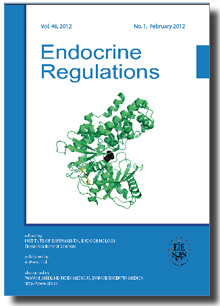Journal info
|
||
Select Journal
Journals
Bratislava Medical Journal Endocrine Regulations 2015 2014 2013 2012 2011 2010 2009 2008 2007 2006 2005 2004 2003 General Physiology and Biophysics Neoplasma Acta Virologica Studia Psychologica Cardiology Letters Psychológia a patopsych. dieťaťa Kovove Materialy-Metallic Materials Slovenská hudbaWebshop Cart
Your Cart is currently empty.
Info: Your browser does not accept cookies. To put products into your cart and purchase them you need to enable cookies.
Endocrine Regulations Vol.47, No.1, p.33–38, 2013 |
||
| Title: Prevalence of metabolic syndrome, insulin resistance, and microvascular angina pectoris in 500 consecutive patients referred to coronarography | ||
| Author: J. Hrnciar, M. Avdicova, D. Gabor, M. Hrnciarova, M. Chamulova, K. Jakubikova, G. Kaliska, V. Kikova, F. Kovar, A. Kreze Jr, J. Lepej, J. Okapcova, M. Szentivanyi | ||
| Abstract: Objective. This work was aimed to evaluate the prevalence of insulin resistance (IR) and metabolic syndrome in a large cohort of 40-60 years old patients with cardiovascular symptoms. Methods. A total of 500 consecutive males and females referred to coronarography and coronary catheterization, because of spontaneous or after load precordial pain plus denivelisation of ST segment by electrocardiography, were included. Besides standard clinical examinations, ergometry, echocardiography, fundamental laboratory tests, and several other laboratory examinations were also performed, including oral glucose toleration test (OGTT), total and high-density lipoprotein (HDL) cholesterol, triglycerides, apoprotein A1 and B, apolipoprotein (a), uric acid, fibrinogen, plasminogen activator inhibitor-1 (PAI-1), cytokines (tumor necrosis factor α, TNFα, interleukin-1, IL-1, interleukin-6, IL-6), endothelin-1, as well as hormones (insulin, C peptide, leptin, growth hormone, cortisol). Results. In 81.6% of patients, IR syndrome with compensatory hyperinsulinemia was found in a positive correlation with various symptoms of metabolic syndrome, including abdominal obesity, increased body mass index (BMI), dysglycemia, dyslipoproteinemia, coronary stenosis, decreased HDL level, and hypertension. Hirsutism with polycystic ovarian syndrome was found in 52% of examined women with IR. However, a normal coronary angiogram, called as a microvascular form of the angina pectoris (MIV-AP), was found in 14% of predominantly periclimacteric and benign hirsutic females with long-term disorders of menstrual cycle. Since these patients showed the same symptoms as their gender, age, BMI, and degree of coronary stenoses adjusted pairs with the macrovascular form (such as the same levels of several lipids, hormones and obesity measures), our data strongly support the view that MIV-AP might belong to the IR syndrome. Conclusions. Hyperinsulinemia and high prevalence of various symptoms of metabolic syndrome (MS) were found in high percentage of patients with after load precordial pain who were referred to coronarography. Similarly, in several women, MIV-AP was detected and its affiliation to MS suggested. |
||
| Keywords: metabolic syndrome, insulin resistance, coronary symptoms, hormones, lipids | ||
| Year: 2013, Volume: 47, Issue: 1 | Page From: 33, Page To: 38 | |
| doi:10.4149/endo_2013_01_33 |
||
|
Price:
12.00 €
|
||
|
|
||

